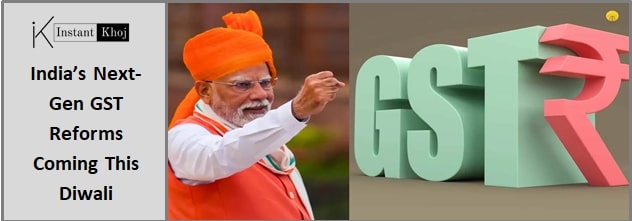Introduction
This Diwali, India’s tax system is set for a major upgrade with the launch of next-generation Goods and Services Tax (GST) reforms. These reforms, years in the making, are designed to address long-standing challenges in compliance, efficiency, and transparency. Nearly eight years after GST’s introduction, the government believes the time is right to modernize the framework, using digital tools and automation to ease taxpayer burden while strengthening revenue collection.
Background: India’s GST Journey Since 2017
When GST was rolled out in July 2017, it was hailed as India’s biggest tax reform, unifying a complex web of central and state levies into a single, nationwide tax. The goal was to simplify indirect taxation, reduce cascading taxes, and create a seamless market across the country.
However, the journey has not been without hurdles. Taxpayers—especially small and medium enterprises (SMEs)—have often struggled with:
- Complex return filing requirements.
- Delays in input tax credit (ITC) refunds.
- Frequent changes in rules and rates.
For the government, issues such as tax evasion, fake invoicing, and revenue leakages have posed persistent challenges.
These shortcomings created a strong case for reforms that are both business-friendly and technologically advanced.
Key Features of the New GST Reforms
The next-generation GST framework, expected to go live during Diwali 2025, promises to bring in several innovations:
- Simplified Return Filing: A single, user-friendly return form with pre-filled details, cutting down on manual entry and errors.
- Faster ITC Processing: Automated, near real-time reconciliation of invoices using AI-driven systems to ensure timely credit availability.
- Enhanced Anti-Evasion Measures: Integration of e-invoicing, real-time transaction tracking, and advanced analytics to curb fraud.
- Technology-First Approach: Greater reliance on AI, machine learning, and automation to reduce disputes and improve compliance accuracy.
- Support for SMEs: Tailored compliance tools and threshold relaxations to help small businesses integrate smoothly into the system.
Timeline and Launch Details
The official rollout is scheduled for Diwali 2025, aligning with the festive season that traditionally marks a surge in business activity. According to government announcements, the new system will be introduced in phases to allow businesses and states sufficient time to adapt.
Role of Consultation in Shaping Reforms
The reforms have been developed through extensive consultations with industry associations, state governments, tax experts, and technology providers. This collaborative approach is intended to balance the government’s revenue needs with the business community’s call for simplified compliance.
Reactions and Expectations from Stakeholders
- Businesses and SMEs anticipate smoother compliance, faster refunds, and reduced paperwork, which will help improve cash flow and competitiveness.
- Tax experts have welcomed the increased use of AI and automation, noting that it could reduce disputes and litigation in the long term.
- Industry bodies see the reforms as a step toward strengthening India’s ranking in global “ease of doing business” indexes.
Expected Impact on Businesses and the Economy
The reforms are expected to:
- Improve cash flow for companies by speeding up ITC refunds.
- Reduce compliance costs and administrative burden, particularly for SMEs.
- Enhance transparency, leading to stronger investor confidence.
- Boost government revenues by minimizing evasion and widening the tax base.
At a macroeconomic level, a cleaner, more efficient GST regime could support higher growth and strengthen India’s attractiveness as a global investment hub.
Potential Challenges and Implementation Strategies
While the benefits are clear, several challenges remain:
- Adoption by SMEs: Smaller firms may face difficulties in transitioning to more digital systems.
- IT Infrastructure Readiness: Ensuring that GST networks can handle larger volumes of real-time data.
- State Coordination: Harmonizing procedures across states to ensure consistency.
The government has indicated that it will roll out training programs, helpdesks, and phased implementation plans to smooth the transition.
Practical Example: How Businesses Might Benefit
Consider a mid-sized textile exporter who previously waited weeks to get ITC refunds, straining cash flow during peak export season. Under the new system, automated ITC reconciliation could allow credits to be processed in just a few days, freeing up working capital and reducing dependence on short-term loans. For many SMEs, this improvement alone could significantly ease financial stress.
Conclusion
The launch of next-generation GST reforms this Diwali marks a pivotal moment in India’s tax journey. By combining technology with simplified procedures, the reforms aim to make compliance easier, improve revenue efficiency, and boost transparency. If implemented smoothly, these changes could transform GST into a true engine of growth—supporting businesses, enhancing India’s global competitiveness, and lighting the path for sustained economic development.
Disclaimer
This article is based on publicly available information as of August 2025. Readers should consult official announcements from the Ministry of Finance and the GST Councilfor the latest updates
Read more articles like this — Click here to explore now





One thought on “India’s Next-Gen GST Reforms Coming This Diwali”